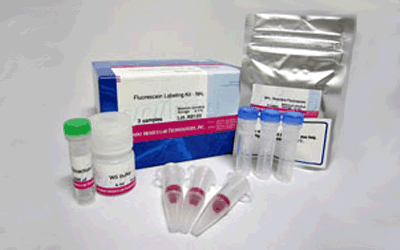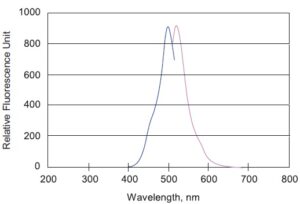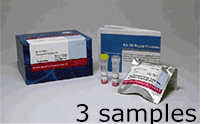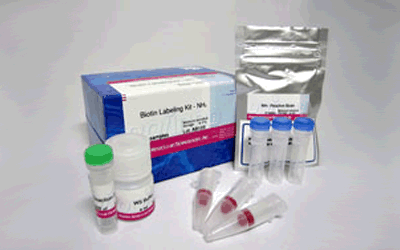Fluorescein Labeling Kit - NH2

Antibody / Protein Labeling
- Only 1 hour to recover conjugates
- All processes in a single Filtration tube
- High recovery of conjugates
- Applicable for 50-200 μg IgG
-
Product codeLK01 Fluorescein Labeling Kit - NH2
| Unit size | Price | Item Code |
|---|---|---|
| 3 samples | $243.00 | LK01-10 |
| 3 samples | ・NH2-Reactive Fluorescein ・WS Buffer ・Reaction Buffer ・Filtration Tube |
3 tubes 4 ml x1 500 μl x1 3 tubes |
|---|
Description
Fluorescein Labeling Kit-NH2 is mainly used for the preparation of fluorescein-labeled proteins such as IgG for immunostaining and cellular proteins for tracing. Amine-reactive fluorescein, a component of this kit, has succinimidyl groups (NHS) that react with the amino groups on proteins or other molecules (Fig. 1). This kit contains all the reagents necessary for labeling, including storage buffer. Each vial of fluorescein can label up to 200 μg of IgG, conjugating about 4 to 6 fluorescein molecules per IgG molecule. Because this kit also includes a buffer exchange system, a sample containing amine base buffer can be labeled. Although membrane filtration sometimes causes IgG aggregation, the buffer system in this kit prevents aggregation during the concentration of IgG or fluorescein-labeled IgG solution. A fluorescein-labeled IgG solution prepared using this kit is stable for more than 2 months at 4ºC. The excitation and emission wavelengths of the fluoresceinlabeled IgG are 495 nm and 520 nm, respectively (Fig. 2).

Fig. 1 IgG labeling reaction of NH2-reactive fluorescein

Fig. 2 Fluorescence spectrum of fluorescein-conjugated IgG
______excitation spectrum
______emission spectrum
Precaution
♦ The molecular weight of the protein to be labeled with this kit should be greater than 50,000.
♦ IgG or fluorescein-conjugated IgG is always on the membrane of the filtration tube during the labeling process.
♦ If the IgG solution contains other proteins with molecular weight greater than 10,000, such as BSA or gelatin, purify the IgG solution before labeling fluorescein with this kit.
♦ If the IgG solution contains small insoluble material, centrifuge the solution and use the supernatant for the labeling.
| Developer | Dojindo Molecular Technologies, Inc. |
|---|
Manual
References
1) M. Hiyoshi, S. Suzu, Y. Yoshidomi, R. Hassan, H. Harada, N. Sakashita, H. Akari, K. Motoyoshi and S. Okada, "Interaction between Hck and HIV-1 Nef Negatively Regulates Cell Surface Expression of M-CSF Receptor", Blood, 2008, 111(1), 243.
2) W. Aung, A. Tsuji, H. Sudo, A. Sugyo, T. Furukawa, Y. Ukai, Y. Kurosawa and T. Saga, "Immunotargeting of Integrin α6β4 for Single-Photon Emission Computed Tomography and Near-Infrared Fluorescence Imaging in a Pancreatic Cancer Model", Molecular Imaging, 2016, 15, 1.
3) A. Shinya, K. Yamamoto, M. Kurata, S. Abe-Suzuki, R. Horii, F. Akiyama and M. Kitagawa, "Targeting MCM2 function as a novel strategy for the treatment of highly malignant breast tumors", Oncotarget., 2015, 6, (33), 34892.
4) K.M. Nishida, T.N. Okada, T. Kawamura, T. Mituyama, Y. Kawamura, S. Inagaki, H. Huang, D. Chen, T. Kodama, H. Siomi and M.C. Siomi, "Functional involvement of Tudor and dPRMT5 in the piRNA processing pathway in Drosophila germlines", EMBO J.., 2009, 28, (24), 3820.
5) P.G. Sreekumar, R. Kannan, M. Kitamura, C. Spee, E. Barron, S.J. Ryan and D.R. Hinton, "αB crystallin is apically secreted within exosomes by polarized human retinal pigment epithelium and provides neuroprotection to adjacent cells", PLoS ONE., 2010, 5, (10), e12578.
6) R. Asano, T. Kumagai, K. Nagai, S. Taki, I. Shimomura, K. Arai, H. Ogata, M. Okada, F. Hayasaka, H. Sanada, T. Nakanishi, T. Karvonen, H. Hayashi, Y. Katayose, M. Unno, T. Kudo, M. Umetsu and I. Kumagai, "Domain order of a bispecific diabody dramatically enhances its antitumor activity beyond structural format conversion: the case of the hEx3 diabody", Protein Eng. Des. Sel.., 2013, 26, (5), 359.
7) R. Asano, I. Shimomura, S. Konno, A. Ito, Y. Masakari, R. Orimo, S. Taki, K. Arai, H. Ogata, M. Okada, S. Furumoto, M. Onitsuka, T. Omasa, H. Hayashi, Y. Katayose, M. Unno, T. Kudo, M. Umetsu and I. Kumagai, "Rearranging the domain order of a diabody-based IgG-like bispecific antibody enhances its antitumor activity and improves its degradation resistance and pharmacokinetics", MAbs., 2014, 6, (5), 1243.
8) R. Asano, K. Ikoma, I. Shimomura, S. Taki, T. Nakanishi, M. Umetsu and I. Kumagai, "Cytotoxic enhancement of a bispecific diabody by format conversion to tandem single-chain variable fragment (taFv): the case of the hEx3 diabody", J. Biol. Chem.., 2011, 286, (3), 1812.
9) T. Toyotome, M. Yamaguchi, A. Iwasaki, A. Watanabe, H. Taguchi, L. Qin, H. Watanabe and K. Kamei, "Fetuin A, a serum component, promotes growth and biofilm formation by Aspergillus fumigatus", Int. J. Med. Microbiol.., 2012, 302, (2), 108.
10) W. Ma, V. Schubert, M. M. Martis, G. Hause, Z. Liu, Y. Shen, U. Conrad, W. Shi, U. Scholz, S. Taudien, Z. Cheng and A. Houben, "The distribution of α-kleisin during meiosis in the holocentromeric plant Luzula elegans", Chromosome Res.., 2016, 24, (3), 393.
11) Y. Yokoi, K. Nakamura, T. Yoneda, M. Kikuchi, R. Sugimoto, Y. Shimizu and T. Ayabe, "Paneth cell granule dynamics on secretory responses to bacterial stimuli in enteroids", Sci. Rep.., 2019, 9, 2710.
12) Y.J. Lee, S.R. Han, N.Y. Kim, S.H. Lee, J.S. Jeong and S.W. Lee, "An RNA aptamer that binds carcinoembryonic antigen inhibits hepatic metastasis of colon cancer cells in mice", Gastroenterology., 2012, 143, (1), 155.
13) C. F.O.Hoya, K. Kushiro, Y. Yamaoka, A. Ryo and M. Takai, 'Rapid multiplex microfiber-based immunoassay for anti-MERS-CoV antibody detection', Sens Biosensing Res., 2019,10.1016/j.sbsr.2019.100304.
14) H. Takeuchi, N Sasaki, S. Yamaga, M. Kuboniwa, M. Matsusaki and A. Amano, "Porphyromonas gingivalis induces penetration of lipopolysaccharide and peptidoglycan through the gingival epithelium via degradation of junctional adhesion molecule 1", PLoS Pathog., 2019, 15, (11), e1008124.
15) Y. Yanase, Y. Matsuo, T. Kawaguchi, K. Ishii, A. Tanaka , K. Iwamoto , S. Takahagi and M.Hide, "Activation of Human Peripheral Basophils in Response to High IgE Antibody Concentrations without Antigens"., Int J Mol Med Sci, 2019, 20, (1), 45.
16) M. Yashiro, M. Ohya, T. Mima, Y. Nakashima, K. Kawakami, T. Sonou, K. Tatsuta, Y. Yamano, S. Negi and T. Shigematsu, "Excessive ADAM17 activation occurs in uremic patients and may contribute to their immunocompromised status.", Immun Inflamm Dis., 2020, 10.1002/iid3.298.
17) H Fujishiro, H Yamamoto, N Otera, N Oka, M Jinno and S. Himeno, "In vitro Evaluation of The Effects of Cadmium on Endocytic Uptakes of Proteins into Cultured Proximal Tubule Epithelial Cells.", Toxics, 2020, 8,10.3390/toxics8020024
18) Y. Liu, Y. Liu, X. Zheng, L. Zhao and X. Zhang, "Recapitulating and Deciphering Tumor Microenvironment by Using 3D Printed Plastic Brick–Like Microfluidic Cell Patterning", Adv Healthc Mater, 2020, 9, (6), 1901713.
Q & A
-
Q
Can I use this kit for other proteins?
-
A
Yes, if the molecular weight is greater than 50,000.
-
Q
Do I have to use a Filtration tube prior to labeling the protein?
-
A
If the protein solution does not contain small molecules with an amino group and the concentration of the protein is 10 mg per ml, or about 70 μM, there is no need to use the Filtration tube. Just mix 10 μl of the sample solution with 90 μl of Reaction buffer and add 8 μl NH2-reactive fluorescein (prepared at step 3) to the mixture, and follow the protocol starting at step 4.
-
Q
How long is the fluorescein-labeled protein stable?
-
A
If you store at 4ºC, it is stable for over 2 months. For longer storage, add 100% volume of glycerol, aliquot, and store at -20ºC. However, please note that stability depends on the protein itself.
-
Q
What is the minimum amount of IgG that can be labeled by this kit?
-
A
The minumum amount of IgG is 10 μg; simply follow the protocol. The labeling ratio remains the same for 10 μg to 100 μg of IgG.
-
Q
Can I use this kit to label oligonucleotides or peptides?
-
A
No. Oligonucleotides and peptides may be too small to retain on the membrane filter of the Filtration tube.
Handling and storage condition
| 0-5°C, Protect from moisture |











